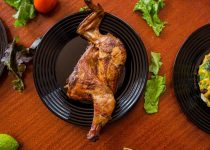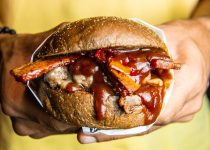Why Is My Backyard Brisket Stalled at 190 Degrees?
So, here's the scoop: I've been smoking a brisket in my backyard, and it's stuck at 190 degrees for what feels like forever. It seems like I've hit that infamous stall, where all the collagen in the meat is breaking down into gelatin, which is essential for that fall-apart tenderness we all love. I know this is a normal part of smoking brisket, but man, it's testing my patience. I'm thinking about wrapping it in foil to speed things up. What do you all think? Have you dealt with this before, and do you have any tricks up your sleeve to get past this plateau?
Table of Contents
Key Takeaways
- The stall is caused by moisture evaporation cooling the brisket, offsetting the heat from the smoker.
- Collagen in the brisket starts breaking down around 190°F, contributing to the temperature plateau.
- High ambient humidity can slow down moisture evaporation, prolonging the stall at 190 degrees.
- Inconsistent smoker temperatures or inadequate heat can cause the brisket to stall at this critical point.
- Wrapping the brisket in foil or butcher paper can help push past the stall by trapping heat and moisture.
Understanding the Brisket Stall
When smoking brisket, hitting the infamous stall around 150 to 170 degrees Fahrenheit is a common and frustrating experience. This stall isn't just a delay; it's a test of patience and skill. Now, let's clear up some stall myths and understand the real deal about stall duration.
First off, the stall is all about moisture, not some mystical meat barrier. As the brisket cooks, moisture on its surface evaporates, cooling the meat like sweat on a runner. This can last anywhere from a couple of hours to over six, depending on several factors such as the size of your brisket, the consistency of your smoker's temperature, and even the humidity around your smoker.
Many folks think wrapping the brisket in foil or butcher paper can “power through” the stall. While this technique, known as the Texas crutch, does speed up cooking by trapping moisture and heat, it doesn't skip the stall. It simply shortens the stall duration by altering the environment around the brisket.
The Science of Meat Plateaus
When your brisket stalls at 190 degrees, a few key processes are at play.
We're looking at how collagen breaks down, how heat transfers within the meat, and how moisture evaporates.
Let's break down these points to understand why this temperature plateau happens.
Understanding Collagen Breakdown
The stubborn stall in brisket temperature around 190 degrees is all about collagen turning into gelatin. This transformation is crucial in achieving that perfect, tender texture we're all after. Collagen types in beef, mainly type I and III, start breaking down under slow cooking conditions, greatly influenced by enzymatic action. This process isn't quick; it's why your brisket seems to 'stall' at those higher temps.
To better understand, here's a quick breakdown:
| Aspect | Details | Impact on Brisket |
|---|---|---|
| Collagen Types | Type I and III | Structural support |
| Enzymatic Action | Breaks down collagen fibers | Softens meat |
| Cooking Temp | Around 190°F | Initiates breakdown |
| Time | Prolonged | Ensures thorough breakdown |
| End Result | Collagen turns to gelatin | Tender, juicy meat |
Heat Transfer Mechanisms
Understanding how heat transfers through meat during cooking can explain why your brisket hits a temperature plateau. As you cook, heat moves into your brisket primarily through conduction, but radiant energy from your smoker also plays a significant role.
The conductive properties of meat aren't uniform; different tissues conduct heat at different rates. As heat slowly diffuses through the brisket, reaching the cooler interior, the outer layers might seem done while the center is still coming up to temp.
Radiant energy, meanwhile, adds a subtle but constant heat source that affects the surface and slightly beyond. It's this intricate balancing act between internal conduction and external radiant energy that can cause your brisket to stall as these forces equalize.
Moisture Evaporation Dynamics
Alongside heat transfer, the moisture evaporation in your brisket greatly influences why temperatures stall during cooking. So, let's explore the nitty-gritty of moisture evaporation dynamics.
As your brisket cooks, the heat causes internal moisture to evaporate. This evaporation rate isn't just a minor detail—it's essential. The brisket cools itself through this process, much like how sweating cools us down.
Now, if the ambient humidity around your smoker is high, the air's already full of moisture, making it harder for more moisture to leave the brisket. This slows down the evaporation rate, causing what we call a “stall.” Understanding this interaction between evaporation rate and ambient humidity can seriously enhance your brisket game.
Factors Influencing the Stall
When my brisket stalls at 190 degrees, it's often due to a couple of key factors.
First off, the mechanics of heat transfer play a huge role; how heat moves through the brisket can really affect the cooking process.
Additionally, the weather outside, like wind or cold, can impact how well my grill maintains the necessary temperature.
Heat Transfer Mechanics
Several factors contribute to the notorious stall in brisket cooking at around 190 degrees. These include moisture evaporation and heat absorption. Radiative heating and conductive cooling play significant roles here. Radiative heating is the heat transfer from the smoker's fire to the brisket without needing direct contact, which can be pretty efficient until the brisket's surface moisture starts to evaporate. Conductive cooling kicks in as the brisket cools with evaporating moisture, akin to sweat on a hot day. This balancing act between heating and cooling forces the internal temperature to plateau, frustrating many pitmasters. Understanding this interplay can seriously up your brisket game.
External Weather Conditions
While we've looked at how heat transfer affects the brisket stall, another key factor is the external weather conditions. Don't overlook how a chilly breeze or a sudden drop in temperature can mess with your cooking times. If it's cold and windy, your smoker loses heat faster than on a calm day. Also, humidity plays a huge role. High humidity can make the stall last longer because the meat retains moisture, slowing down the temperature rise.
Interestingly, how you've set up your garden can impact this too. If you've got tall hedges or buildings blocking the wind, your smoker's more sheltered, which can help maintain a consistent temperature. Even seasonal allergies might throw you off your game, making you less likely to monitor and adjust as needed.
Monitoring and Controlling Temperature
Keeping a close eye on your smoker's temperature is crucial to avoid the dreaded stall in cooking brisket. When you're aiming for that perfect tender result, fluctuations in temperature can really throw a wrench in your plans. That's why I always recommend investing in good temperature probes. These handy grilling accessories allow you to monitor the internal temp of your brisket without constantly opening the smoker, which can lead to heat loss and extend your cooking time.
Now, to get technical, maintaining a steady smoker temperature between 225 and 250 degrees Fahrenheit is essential. I've found that setting up my temperature probes before even prepping my brisket gives me a bit more control. It lets me focus on the meat's seasoning and prep without worrying about heat spikes or drops.
It's also crucial to position your temperature probes correctly. One should be in the thickest part of the brisket, not touching any fat or bone. The other should gauge the ambient temperature of your smoker. This dual approach helps me tweak the vents or fuel supply to maintain that sweet spot, ensuring my brisket cooks evenly and avoids stalling at those higher temps.
Wrapping: Pros and Cons
After discussing how to monitor and control your smoker's temperature, let's now explore the pros and cons of wrapping your brisket. Deciding whether to wrap can have a big impact on both the cooking process and the final outcome. So, I'll break down what I've learned through my experiences and research.
Wrapping, often with foil or butcher paper, can influence your brisket in several ways:
- Flavor Impact: Wrapping can help maintain moisture and juices that would otherwise evaporate. This means the brisket remains tender and can enhance the depth of flavors. However, you might miss out on that perfect bark formation, which is a crucial component for many barbeque aficionados.
- Efficiency: It speeds up the cooking process by overcoming the dreaded stall (where the internal temperature of your brisket plateaus). This can be a game-changer when you're pressed for time.
- Cost Effectiveness: Using materials like aluminum foil or butcher paper isn't a big financial strain, but it's an additional cost that adds up over multiple smoking sessions.
For me, the decision to wrap depends heavily on my schedule and the specific flavor profile I'm aiming for. While wrapping can guarantee a moist and tender brisket, sometimes I just crave that unbeatable bark that only unwrapped, slow smoking can achieve.
Adjusting Cooking Techniques
When my brisket stalls at 190 degrees, I start by tweaking my heat source; sometimes it just needs a bit more oomph.
I've also tried wrapping the brisket in foil to lock in moisture and push past the stall.
Checking the humidity levels in my smoker can really make a difference in cooking times.
Modify Heat Source
If your brisket stalls at 190 degrees, consider adjusting your heat source to maintain a consistent temperature. Sometimes, the type of fuel and how you manage airflow can make a big difference.
Here's what I've learned:
- Guarantee Fuel Types: Different fuels burn at different temperatures. Hardwood might provide a steadier heat than briquettes, depending on your setup.
- Boost Airflow: Increasing airflow can raise the temperature. Guarantee your smoker's vents are adjusted correctly to allow more air to the fire.
- Check Equipment Integrity: Sometimes old or faulty equipment doesn't distribute heat evenly. Double-check for any wear or damage.
Wrap Brisket Technique
To overcome the frustrating stall at 190 degrees, wrapping your brisket in foil or butcher paper can greatly aid in pushing the temperature past this point. I've tried both, and each has its perks. Foil is great for trapping moisture, speeding up the cooking process. Butcher paper, on the other hand, lets the meat breathe a bit, enhancing the bark's texture without sacrificing too much on time.
Here's a quick comparison to help you decide:
| Material | Benefits |
|---|---|
| Foil | Faster cooking, retains more moisture |
| Butcher Paper | Better bark, still speeds up cooking |
Both options beat waiting out the stall without any wrap. Experiment to see what works best for your setup!
Check Humidity Levels
After tackling the wrap technique, let's now focus on how checking humidity levels can further refine our brisket cooking process. Monitoring the humidity around your brisket, especially if you're cooking outdoors, can be a game changer. Here's why:
- Humidity Measurement: Using a hygrometer can help you keep tabs on moisture levels, which greatly affect cooking times.
- Indoor vs Outdoor: Cooking indoors usually means more control over environmental conditions compared to the unpredictable outdoors.
- Adjustments: If humidity is low, consider misting your cooking area or adjusting your smoker's vent settings to maintain moisture.
Getting this right isn't just about following steps; it's about mastering the variables to achieve that perfect brisket every time.
Importance of Humidity and Airflow
Understanding how humidity and airflow affect your brisket's cooking process is essential when you're faced with a stall at 190 degrees. Let's break it down: air circulation and ventilation effectiveness can make or break your cook. If you're seeing that dreaded temperature plateau, it's time to check these elements.
First, consider the setup of your smoker. Good air circulation is vital because it helps maintain a consistent temperature and smoke flow around the meat. If your smoker is choked up, the airflow can be restricted, causing uneven cooking and that annoying stall. You've got to make sure that the vents are open enough to facilitate a smooth flow but not too much, which can dry out your brisket.
Now, let's talk humidity. It plays a massive role in how heat is transferred within your cooking chamber. Too little humidity and your brisket might dry out, making it tough. Too much and you might find the exterior getting mushy before the interior is done. Balancing this can be tricky, but it's all about managing your water pan and keeping an eye on internal conditions.
Patience and Time Management
When your brisket stalls at 190 degrees, patience isn't just a virtue—it's a necessity. I've been there, watching the thermometer hover endlessly, and I've learned that managing my expectations and planning my time wisely are key to not just a great brisket, but also to keeping my sanity intact.
Here's how I handle the stall with effective time allocation and stress management:
- Plan Ahead: I always assume the brisket will take longer than expected. This way, I'm not stressed if I'm running behind schedule.
- Keep Busy: I use the time to prep sides or tidy up. It keeps me from constantly checking the temperature and fretting.
- Relax: I remind myself that the stall is part of the process. A good book or playlist can make the wait enjoyable rather than frustrating.
Understanding that the 'stall' in brisket cooking is a natural moisture evaporation process helps me stay calm. It's not a setback; it's an essential phase that contributes to the flavor and texture of the meat. I've learned that rushing it or getting worked up won't help. So, I allocate my time, manage my stress, and look forward to the delicious outcome.
Troubleshooting Common Pitfalls
Even with the best planning, you might encounter a few common pitfalls while cooking brisket. Let's dig into a couple of these and figure out how to get past them.
First off, ingredient quality can make or break your brisket experience. If you're starting with a low-grade cut, no amount of smoking will give you that buttery texture and rich flavor we're all after. I always recommend splurging a bit on a higher grade like Choice or Prime. Trust me, it's worth the extra bucks.
Now, let's talk about fuel type, which is essential. Whether you're using charcoal, wood, or a combo, consistency in heat is key. If your brisket's stalling, it might be because the heat's fluctuating too much. Charcoal can burn unevenly if not managed properly, and some woods burn faster than others. My go-to is a steady supply of oak or hickory, and I keep a close eye on the temperature gauge to make sure it's steady. Avoid lesser quality fuels that can introduce unwanted flavors or burn too quickly.
Ensuring Perfect Doneness
To guarantee your brisket reaches perfect doneness, it's important to monitor its internal temperature closely. But what do you do once it hits the right temp? Well, there are a few more tricks to master to make certain your brisket isn't just cooked, but cooked to perfection.
After removing your brisket from the heat, let it rest! This might be the hardest part because, let's face it, it smells amazing and you're hungry. But patience pays off. Resting allows the juices to redistribute, making each bite as flavorful as possible. Then, it's on to cutting and serving, where technique really matters.
Here are some pro tips:
- Cutting Techniques: Always slice against the grain. This means cutting crosswise, not along the length of those muscle fibers. It makes your brisket more tender.
- Serving Suggestions: Keep it simple. A light brush of sauce or a sprinkle of your favorite brisket rub can enhance the flavors without overpowering.
- Temperature Check: Use a reliable meat thermometer to check doneness. Aim for an internal temperature of 195-203°F, as this range is generally accepted as the sweet spot for perfect brisket.
Mastering these aspects ensures that your brisket isn't just good, it's backyard-barbecue legendary.
Frequently Asked Questions
Can Altitude Affect Brisket Cooking Times?
Yes, altitude can definitely impact brisket cooking times. Pressure effects and boiling point changes at higher altitudes mean I've need to adjust my cooking method to make sure my brisket cooks thoroughly.
Do Different Wood Types Impact the Stall Period?
Different wood types do affect the stall period by altering moisture content and heat distribution. I've found that denser woods can lead to longer stalls due to their slower, more consistent heat output.
Is It Safe to Leave Brisket Resting Overnight?
I've found it's safe to leave brisket resting overnight if you're careful with temperature monitoring. Just make sure it's in a cool, safe spot and use proven resting methods to maintain quality.
How Does Brisket Stall Vary With Different Grades of Meat?
I've noticed that brisket stall varies with meat grade due to marbling effects and meat density. Higher marbling often means a longer stall as the fat renders slowly, affecting cooking time considerably.
Can Marinating Brisket Reduce the Stall Duration?
I've found that marinating brisket can impact the stall duration. The marinade ingredients interact with the meat's fibers, potentially altering the stall science, which could shorten the time it takes to cook through.




